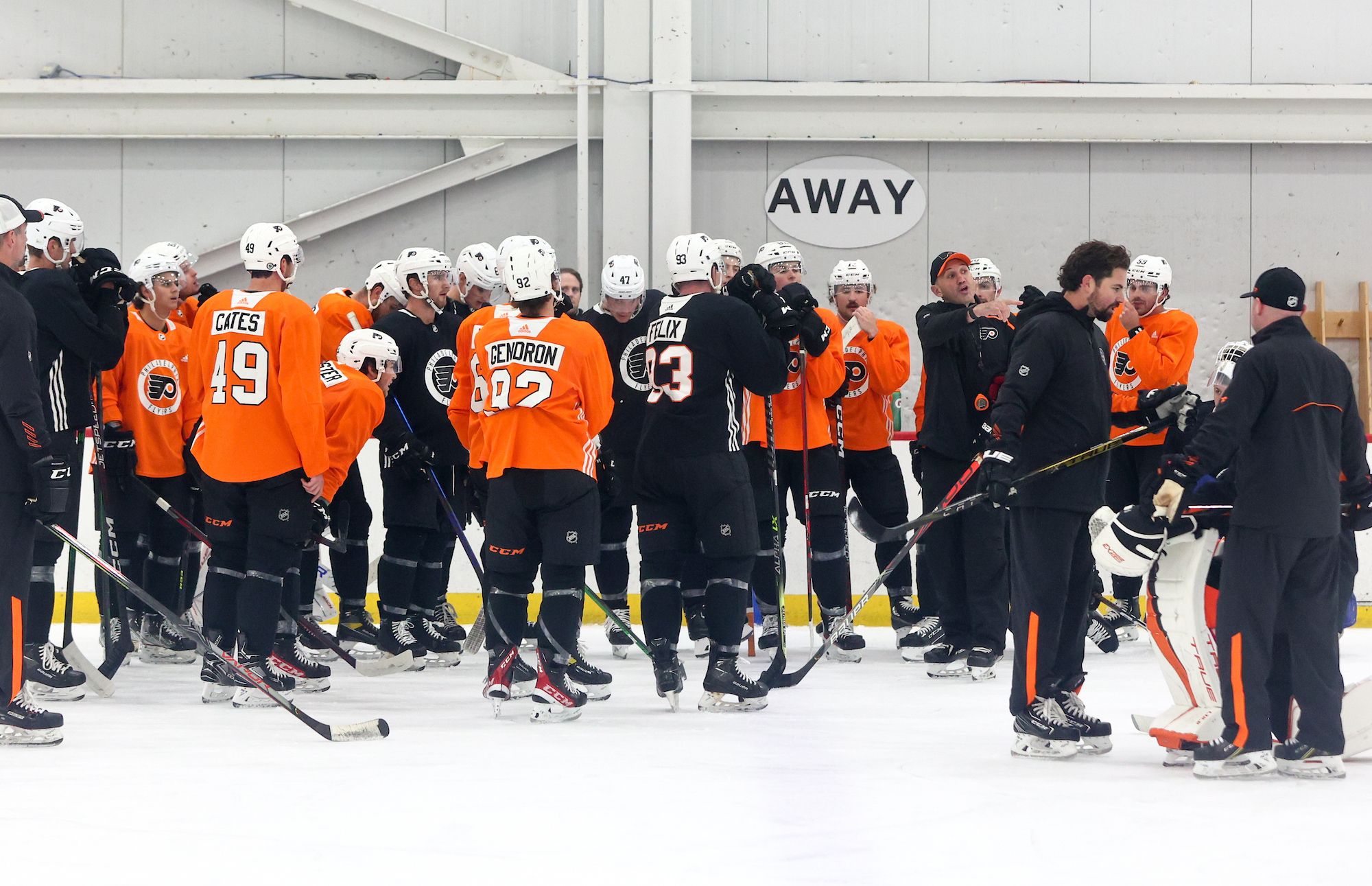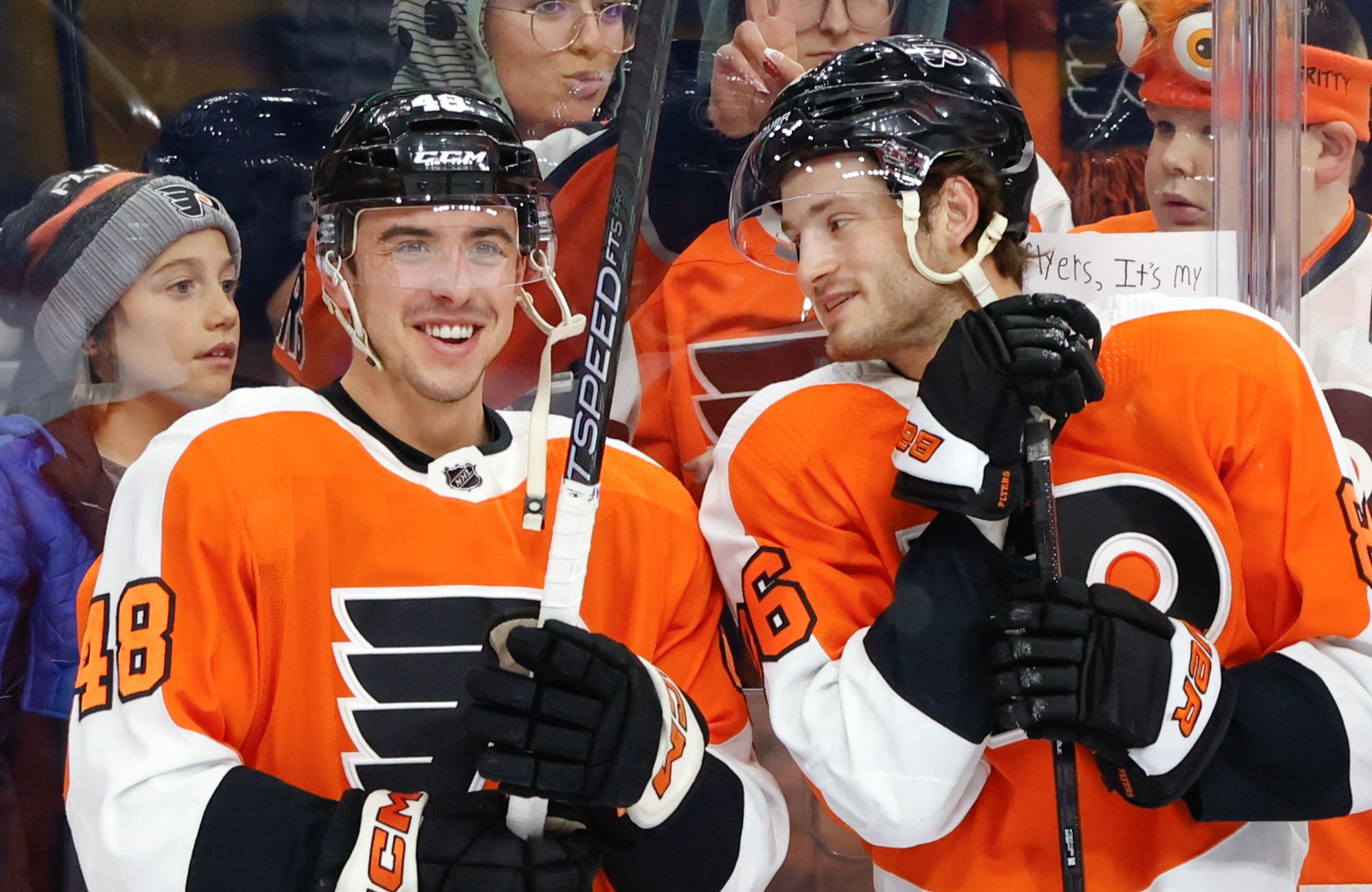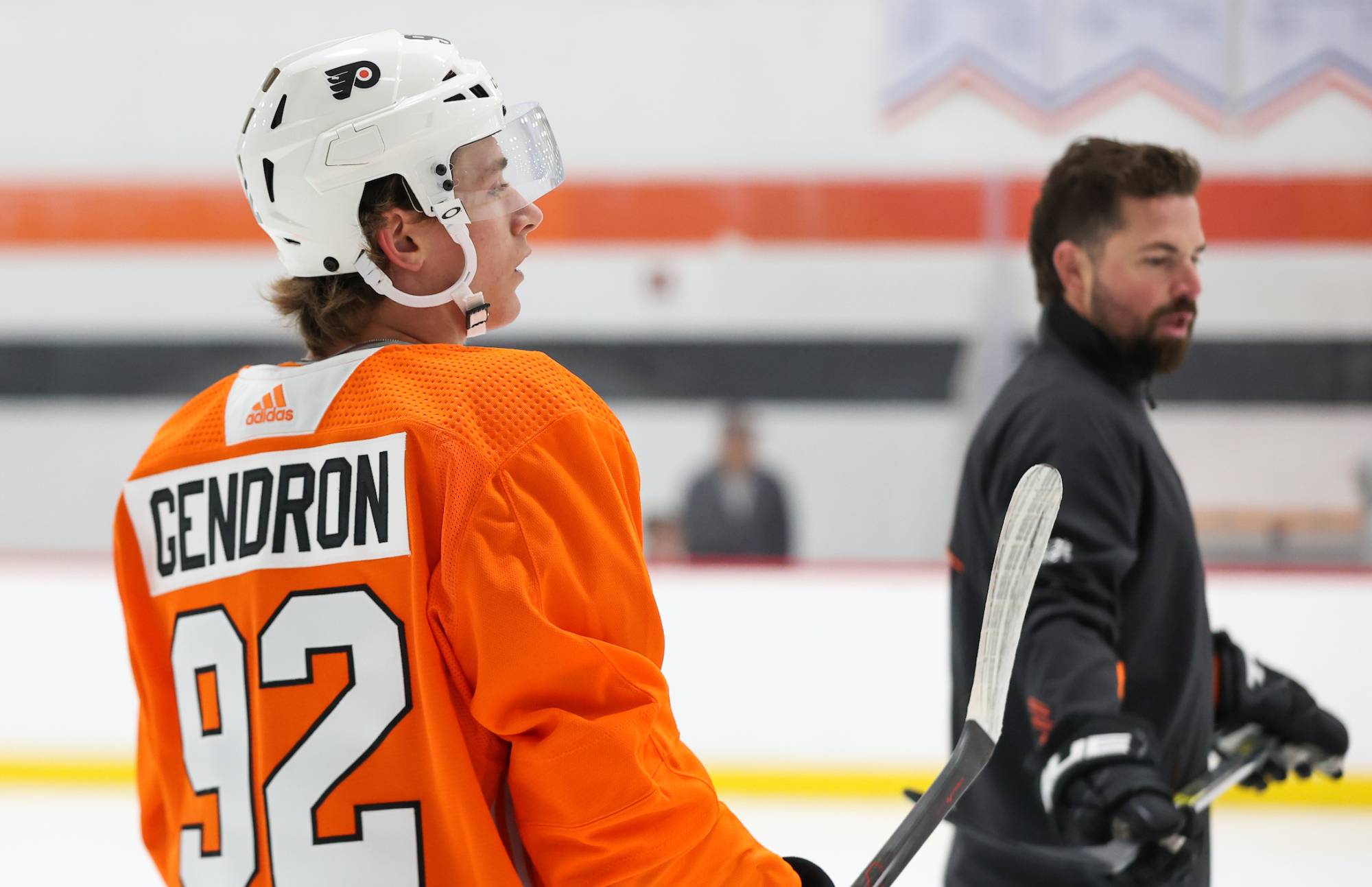Morning Observations is a feature where we break down the previous night’s game with an analytical eye.
#1: Similar to Saturday’s game, except without all the goals
It may seem inaccurate to compare a 1-0 overtime victory to a 4-2 win, but in structure, both games this weekend for the Flyers followed the same formula. On Saturday, Philadelphia got off to a slow start at 5-on-5, finishing with a 26.92% Corsi For percentage, before turning things around over the final 40 minutes and nearly erasing the entire deficit. Last night, the deficit wasn’t quite as large, but the Flyers this time posted a poor 34.78% Corsi. It was also due to the same reason — poor defensive zone shot suppression that allowed their opponent to control play.
Against Detroit, however, the Flyers came all the way back to end up on top of all the key statistical charts, which they couldn’t quite pull off against the Stars. They finished with a 51.62% score-adjusted Corsi, 56.98% once blocked shots were removed from the equation (Fenwick), and then a strong 60.98% xG. And just like on Saturday, they did it by slowing the game down, specifically in the neutral zone. Detroit barely had any space to breathe out there, which meant less offensive zone time and fewer chances. In fact, over the game’s final 40 minutes, Detroit could muster just one high-danger chance at 5v5. The only time that the Red Wings truly looked dangerous was on the power play, but at even strength, they were rendered toothless by an aggressive Philadelphia defense led by Ivan Provorov, who finished with a team-high 24:56 minutes of total ice time.
#2: What does this streak mean?
Nine-game winning streaks don’t come around very often. In fact, the last time the franchise was able to rattle off nine consecutive victories was way back in 1995, showing how unlikely of a run this truly is. In just a few weeks, Philadelphia has erased their underwhelming start and put themselves in great position for a second straight playoff berth, and they’ve done it with key contributors like Sean Couturier, Michal Neuvirth and Matt Read out for most of the run.
However, the underlying numbers during the team’s nine-game stretch haven’t been anything special. They’ve posted a 47.41% score-adjusted Corsi and a 43.98% xG percentage, neither of which would rank them anywhere close to their current place in the NHL standings. Also, they’re worse than the full-season rates that Philadelphia had posted prior to the streak. That’s simultaneously concerning and reassuring. It’s concerning because they’re obviously playing over their heads right now, flourishing due to unsustainable shooting and save percentages at 5v5. But it’s also reassuring because the Flyers have shown that they are capable of better underlying performances, and the biggest dropoff in Corsi and xG occurred just after the team lost Couturier and Read, two of their best play-drivers.
Yes, the Flyers are getting “lucky” now. But the realistic hope is that when the pendulum starts swinging the other way as it inevitably will at some point, those key players will be on the verge of a return and the underlying numbers will rebound. For now, it’s best to just enjoy the ride, and hope that improved goaltending, a stellar power play, and good fortune keeps dragging the Flyers to wins.
NHL.com Report & Highlights | Corsica.Hockey Game Recap Page | HockeyStats.ca Recap | NaturalStatTrick Recap | HockeyViz.com | BSH Recap | Meltzer’s Musings
#3: Stolarz got better as the game progressed
Through the first 30 minutes of last night’s contest, Anthony Stolarz was somehow both delivering an impressive shutout performance and also looking fairly shaky. Sure, he had stopped every shot, but that result was as much due to the defense in front of him clearing a number of rebounds that the young goaltender had allowed. Stolarz’s positioning was strong on first opportunities, but a consistent inability to hold pucks in his glove or swallow them up in his pads led to some scary moments.
That all changed in the game’s second half. Forced to ward off three Detroit power plays, Stolarz settled in, and began to resemble a human vacuum cleaner. Gone was the leaky glove hand, replaced by a steady catcher’s mitt that was regularly putting an end to any stretches of sustained Red Wings pressure. In the end, Stolarz made 28 saves and faced 17 scoring chances, including nine in the third period. But Detroit could not dent the rookie, and probably regretted that they didn’t take advantage of his early issues. Because by the end of the game, Stolarz was a brick wall.
#4: First line took a while to get going
Through the game’s first two periods, the Philadelphia top line of Claude Giroux, Jakub Voracek and Michael Raffl was largely MIA in terms of providing positive results. They didn’t generate a single shot attempt in the opening stanza, and were little better as a unit in the second. Sure, there were good moments — Claude Giroux continues to shed his aversion to controlled zone entries, Voracek remains a brute force while possessing the puck — but tangible offense just wasn’t there.
That changed in the third period, however, when the line delivered multiple shifts of pure domination. In fact, on the strength of their strong closing kick to the game, the trio ended up basically breaking even in score-adjusted Corsi (only Giroux finished below 50%), and they all finished between 78% and 81% in xG. With the other lines at less than full strength due to injuries, the Giroux unit needs to deliver strong results to justify staying together, and due to that solid finish, they did just that.
#5: The old Andrew MacDonald is back
It was fun while it lasted. For about a week, Andrew MacDonald was not playing like the possession drag that he had been on Shayne Gostisbehere for the better part of two months; instead, he had actually formed a solid partnership with the Flyers’ other young phenom on defense, Ivan Provorov. Dave Hakstol was using the duo as his “shutdown” pairing, and it was actually working — despite tough matchups, Provorov and MacDonald were coming out on top. In fact, MacDonald himself finished with a positive Corsi relative to his teammates in six out of seven games from 11/25 through 12/6. It was refreshing to see.
However, the safest bet is always to assume that if a player with poor historical results gets on a hot streak, it’s just that — a brief stretch of solid play that can’t be expected to hold. Over the past four games, MacDonald has posted Corsi For percentages of 33.33%, 40.74%, 32.00% and 33.33%, finishing negative relative to his teammates in the final three contests. To MacDonald’s credit, he’s still avoiding the backbreaking mistakes that plagued him early in 2016-17, but the little errors are back. He’s conceding the blue line too easily, losing puck battles in the defensive zone, and delivering passes just inaccurate enough to slow down the transition game. My suspicion is that his solid play prior to this recent four-game stretch will give him a long leash, but I wish that wasn’t the case. At best, MacDonald is a third-pair defenseman, and he’s again playing like one. This “top-pair” experiment needs to come to an end.
#6: Provorov, on the other hand, is awesome
Even though his time spent alongside Andrew MacDonald last night served to deflate his on-ice attempt differentials (45.61% score-adjusted Corsi), Ivan Provorov remained one of the Flyers’ best players last night via the eye test. He was all over the ice — breaking up zone entries and engineering zone exits at 5v5, looking like a master disruptor on the PK, and even setting up the game winner via a perfect give-and-go with Brayden Schenn in overtime. The shot quality metrics support the eye test — Provorov finished with a strong 74.91% xG at 5v5 despite surely spending more time in the defensive zone than on the attack.
I’d love to see Provorov no longer paired with MacDonald, but that’s mostly because it’s disappointing to see his advanced metrics crater despite undeniably solid play. They’re simply not telling an accurate narrative. The true narrative is this — Provorov is getting top pair minutes, primarily against top lines, alongside one of the worst play-driving defensemen in hockey, and he’s still helping the team to a nine-game winning streak.
#7: Is the penalty kill legitimately getting better?
If you had to pick a “star of the game” for Philadelphia, there’s a strong argument it should go to an entire unit — specifically, the team’s oft-maligned penalty kill. They faced five Detroit power plays and kept them off the scoresheet on all of them. Granted, goaltender Anthony Stolarz deserves a significant amount of credit for the PK’s performance last night, as he was stellar. But led by Ivan Provorov, the Flyers also limited Detroit’s shots. In fact, out of the 14 penalty killers that saw ice time against the Red Wings, 11 of them posted Corsi Against per 60 rates below 85. That would have put them solidly in the top-ten in shot prevention last season as a team.
Now up to an 81.7% efficiency rate, Philadelphia is quickly moving into a respectable spot on the charts. In addition, they’re out of the basement in the shot prevention charts as well, ranking 19th in Corsi Against per 60, 15th in Fenwick Against, and 9th in xG Against. Hopefully my manual tracking will help to shed more light on a possible improvement in the coming weeks, but it sure looks like the Flyers are starting to get the hang of the tactical adjustments that were made to the PK to start the year.
#8: Schenn the hero, but struggles again at 5v5
For the second straight night, Brayden Schenn scored right when the Flyers needed him to do so. This time, he waited until the 3-on-3 overtime to present himself as the hero, taking an Ivan Provorov pass and then unleashing a beautiful deke in close to beat Jimmy Howard for the gamewinner. That’s four goals in three games, and the perfect way to continue the “Brayden is back!” narrative.
There’s only one problem. After a solid 5v5 performance on Saturday to support his unlikely power play hat trick, his line fell back into bad habits against Detroit. They started strong — Konecny was storming down the ice with purpose, and Schenn was even making slick defensive zone passes. But as the game progressed, Detroit started spending more and more time attacking while the Schenn line was on the ice at even strength. The result was a poor 43.70% score-adjusted Corsi for Schenn, and an even-worse 29.22 xG%. It’s great that the goals are coming, but all four have come in non-5v5 situations. Schenn’s biggest issue remains.
#9: Athanasiou finally shut down
Over the past two seasons, Andreas Athanasiou has been a thorn in the side of the Flyers in every matchup. Not only had he scored in all four matchups against Philadelphia, his speed proved nearly impossible for the Flyers’ limited defense to handle. Last night, however, Philadelphia finally found a way to slow Athanasiou. In 10:10 of total 5v5 ice time, the 22-year old posted a team-low 35.99% score-adjusted Corsi, and was on the ice for just six Detroit shot attempts. He was a non-factor.
That’s not to say that there weren’t some moments where it looked like he was about to break through. But his kryptonite proved to come in the form of Ivan Provorov, who singlehandedly disrupted a few Athanasiou rushes. In fact, in three minutes versus Provorov, the Detroit forward posted a 0.0% Corsi, facing four Flyers shots and helping to create none. Maybe all the Flyers needed to nullify Athanasiou was a stellar young talent of their own.
#10: Giroux, not Bellemare, used as shutdown center
Over the past week, it has been the checking line of Pierre-Edouard Bellemare, Chris VandeVelde and Roman Lyubimov that has been used as the tough minutes line, against star forwards like Connor McDavid, Alex Barkov and Tyler Seguin. The results have been mixed — Bellemare was able to keep them off the scoresheet at 5v5, but in all three matchups, the superstars were able to get the better of territorial play.
Last night, Hakstol changed things up a bit, this time using the top line of Giroux, Voracek and Raffl against Detroit’s dangerous Larkin-Nielsen-Glendening line. 11:25 of Giroux’s 16:28 minutes at 5v5 came matched up against the Nielsen line, and while it’s certainly more difficult for Hakstol to pick his battles on the road, my guess is that this was intentional. The Bellemare line, on the other hand, was used as a third line at even strength, with their minutes spread out against the remaining three Detroit trios.
The results? Giroux basically broke even against Larkin and his friends, finishing with a 51.62% score-adjusted Corsi against them. And in easier minutes, the checking line also drove play, with Bellemare finishing at a 58.73% SA-Corsi, +10.17% relative to his teammates. This strategy — matching fire with fire rather than throwing fourth liners to the wolves — feels like a more sustainable plan over the long-term. We’ll see if it holds this week.









